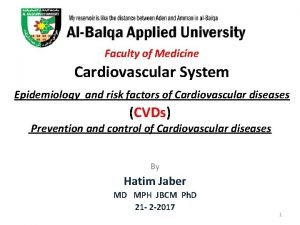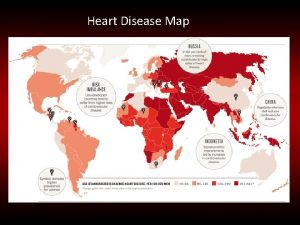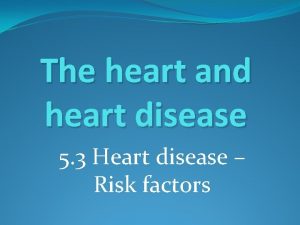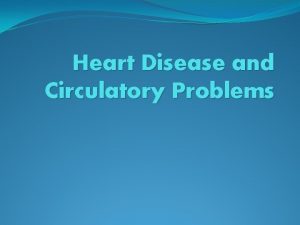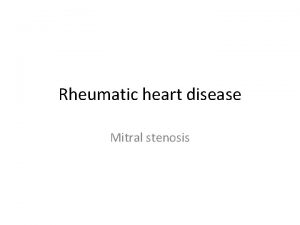Its Never Just Heart Disease And Rarely Just











- Slides: 11

It's Never Just Heart Disease. . . And Rarely Just Illness

The Archetype The use of disease as a metaphor for human flaws and character. It reveals an aspect of the human condition. Heart disease is a particularly symbolic disease as it normally stands as a metaphor for heartbreak.

Rule #1 Not all diseases are created equal • Tuberculosis, or consumption, was an extremely common illness in 19 th century literature • Illnesses that could be associated with sexual transmission were considered taboo and rarely used

Rule #2 The disease should be picturesque • Martyr • Sense of Awe or bizarre beauty

Rule #3 It should be mysterious in origin. § Using an illness whose origin is easily determined takes away its symbolism

Rule #4 It should have strong symbolic or metaphoric possibilities: • Tuberculosis "dying of consumption" (whole body begins to fail including mind) • Heart Attack (heart break) • Malaria "bad air" (bad company/environment)

In Invisible Man • Chapters 2&3 - Mr. Norton • Mr. Norton, a white northern liberal becomes faint and dizzy after listening to Mr. Trueblood's story. The dizziness of the head represents his conflicted conscience. He considers himself a generous man who gives back to the black community, but he receives a feeling of superiority from this that he greatly enjoys. • Chapter 11 – The Narrator • • • The narrator experiences a head injury from the boiler explosion, that makes him go unconscious. His head injury represents his confusion of his identity. This enhances theme of the book because the book is about identity and the lack of it.

In Crime and Punishment • Tuberculosis is prominent in St. Petersburg Russia • The novel takes place right after the emancipation of serfs in Russia • The poor lived in filthy conditions, all very close together • Tuberculosis served as a symbol for poverty and suffering

In Little Women §Beth is described as the quiet, caring sister throughout the novel §When helping their impoverished neighbors, Beth catches scarlet fever which does not heal §Eventually, Beth dies from heart failure §Beth's heart failure symbolizes her sacrificial nature; her heart could no longer take the sacrifice that she would give §Alcott's sister died of scarlet fever but her decision to have Beth die from heart failure allows the death to be more symbolic of her sacrifice to family and friends

Other Examples • The Walking Dead • In the walking dead, zombification in its entirety can be seen as an allegory for the modern "epidemic" of moral detachment. • The modern world allows us to view fellow men with increasing indifference, just as the characters in the walking dead are unable to see humanity in those who have been "zombified".

Bibliography Alcott, Louisa May, and Lucia Monfried. Little Women. Baronet Books, 2008. Ellison, Ralph. Invisible Man. New York: Random House Inc. , 1952. Print. Dostoyevsky, Fyodor, and Constance Garnett. Crime and Punishment. Canterbury Classics, 2018. Foster, Thomas C. How to Read Literature like a Professor: a Lively and Entertaining Guide to Reading between the Lines. Harper, an Imprint of Harper. Collins Publishers, 2017. Koreypatrizi. “Dostoevsky’s Crime & Punishment: Tuberculosis as an Indirect Characterization of the Lower Class. ” PLE Disease Ecology, 5 July 2015, plediseaseecology. wordpress. com/2015/07/02/dostoevskys-crime-punishment-tuberculosisas-an-indirect-characterization-of-the-lower-class/.
 Always usually never
Always usually never Communicable disease and non communicable disease
Communicable disease and non communicable disease Your love never fails, it never gives up
Your love never fails, it never gives up We are never weary of the grand old song
We are never weary of the grand old song Because you speak english unnaturally
Because you speak english unnaturally He never polishes his shoes, so he never looks smart.
He never polishes his shoes, so he never looks smart. God never fails wallpaper
God never fails wallpaper What runs but never walks has a mouth that never talks
What runs but never walks has a mouth that never talks Cyanotic congenital heart disease
Cyanotic congenital heart disease Heart disease and stroke are the world's biggest killers
Heart disease and stroke are the world's biggest killers Present perfect simple ever never
Present perfect simple ever never Heart disease symptoms
Heart disease symptoms









